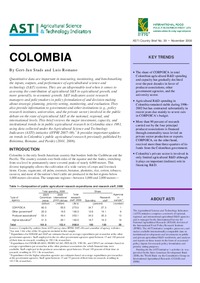Authors:
Stads, Gert-Jan; Romano, Luis
Year:
2008
Publisher
International Food Policy Research Institute (IFPRI)
Back to:
After a decade of strong growth during the 1980s, the expansion of overall agricultural research capacity in Colombia stalled in the mid-1990s. In 2006 the country as a whole employed roughly 1,000 fte scientists involved in agricultural R&D. A rapid fall in the number of research staff at CORPOICA combined with increased agricultural research activities undertaken by producer associations, higher education agencies, and government agencies other than CORPOICA have increasingly diversified the institutional structure and focus of agricultural R&D in Colombia.
A similar shift was seen in the composition of agricultural research spending. The share of CORPOICA, and its predecessor ICA, in total Colombian agricultural R&D spending has gradually declined over the past decades in favor of producer associations, other government agencies, and the university sector. Agricultural R&D spending in Colombia remained stable during 1996–2002 but has contracted substantially in recent years due mainly to severe cuts in CORPOICA’s budget. In 2006 Colombia invested $152 million (in 2005 constant prices) in agricultural R&D, or 0.50 percent of the country’s agricultural output. In terms of public sector intensity of investment in agricultural R&D, Colombia rates well below many of its Latin American counterparts.
Although Colombia’s private sector is involved in very limited agricultural research itself, it plays a rather active role in (indirectly) financing it. More than 90 percent of research carried out by the country’s four principal producer associations is financed through commodity taxes levied on private sector production or exports. CORPOICA, on the other hand, received more than three-quarters of its funds from the Colombian government, with the remainder coming from internally generated resources, the private sector, and foreign donors. In recent years, competitive funds have become increasingly important in financing agricultural R&D in Colombia.
Many challenges lie ahead for Colombia. The international integration process of the Colombian economy, and of the agricultural sector in particular, is taking place in a global setting in which knowledge and technological development and innovation are becoming increasingly important factors. The Free Trade Agreement with the United States currently pending approval presents an opportunity for Colombia to increase trade access for its products. Agricultural research is key to improving the productivity and competitiveness of Colombia’s agricultural sector. The current pattern of declining agricultural R&D spending and bias toward short-term research needs to be reversed. A boost in agricultural research spending and a clear long-term national research strategy that involves both the public and private sector are therefore called for if Colombia’s agricultural sector is to compete in a new global market.

